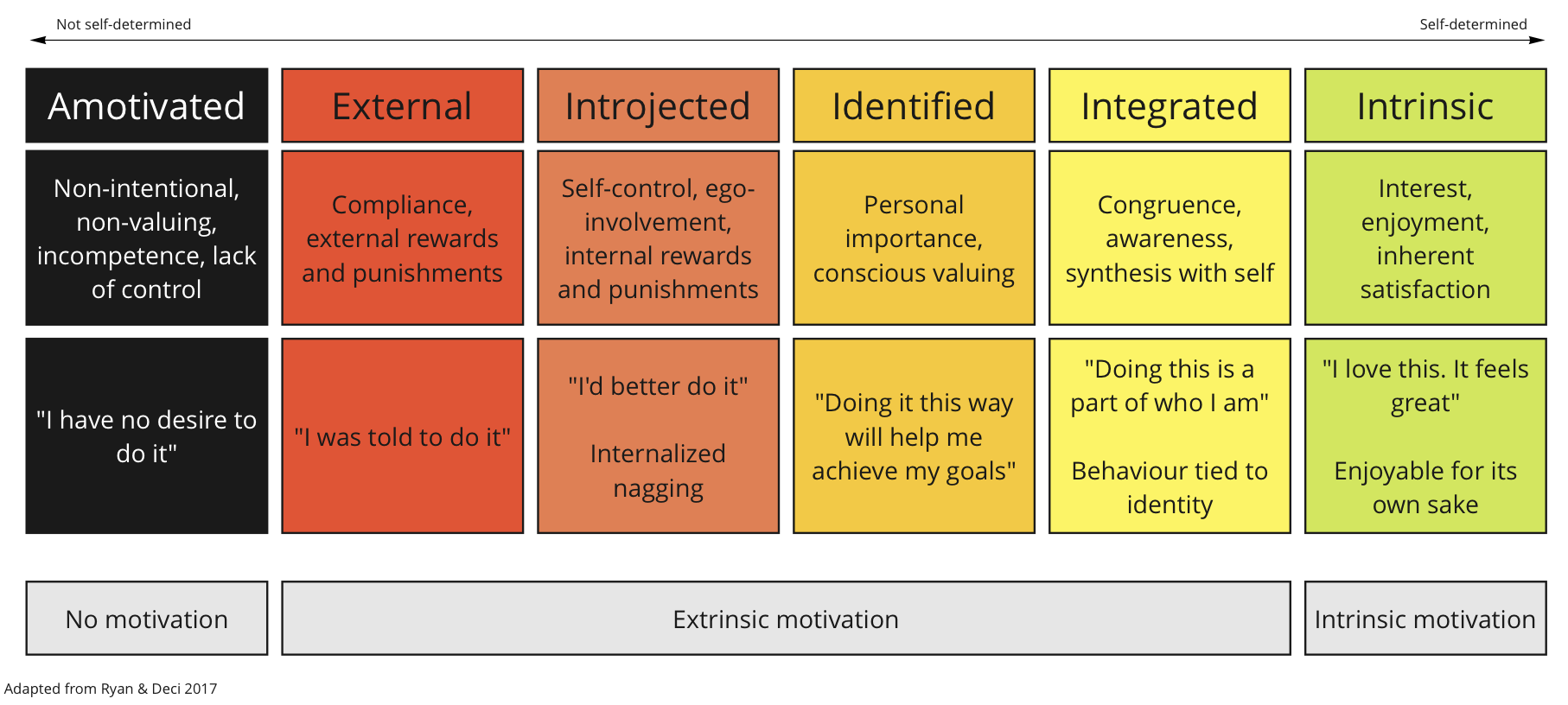We tend to over-simplify motivation into just two buckets: intrinsic and extrinsic. According to Self-Determination Theory (SDT)1, there are in fact six kinds of motivation2 and it’s worth considering the full range.
This chart shows the six groupings laid out by the level of self-determination with the least self-determination on the far left (Amotivated) and the most self-determination on the far right (Intrinsic).

| Type | Description |
|---|---|
| Amotivated | No desire to do it. If it happens at all then it was an accident or a side effect of something else. |
| External | “I was told to do it” and there are likely external punishments and/or rewards involved. |
| Introjected | Internalized nagging. “I feel that I should do it to meet my own goals.” This is driven by self-control and internal rewards or punishments. |
| Identified | “Doing this will help me achieve my goals.” I may not care about this activity for itself but doing it will move me closer to a goal that I do care about. |
| Integrated | Doing this is part of who I am. “I volunteer at a food bank because I am kind”. Behaviour tied to our identity. |
| Intrinsic | “I love this - it feels great.” Enjoyable for it’s own sake. |
To get the best results from ourselves or our people, we want to be intrinsically motivated. Failing that, we want to be as far to the right (more self-determined) as we can be.
How would we make that shift to the right? At a high level, SDT tells us that there are three key psychological needs, and the more of these that we have, the further to the right we’ll be. They are autonomy, competence, and relatedness.
Autonomy is the psychological need to feel in control of one’s own behaviors and goals, to feel that we have control over our own decisions and actions. That not to say that we’ll always have complete control of any situation - there will always be laws, or rules that we have to work within. This is a sliding scale where more autonomy is better than less autonomy. It’s ok that I’ve been told what to work on, if I can decide how I’m going to do it. If I’m told both what and how then my autonomy has been stripped away.
Management often struggles to give up control to their people and then when less autonomy is provided, they wonder why people are less motivated.
Autonomy is also a key component of psychological safety, and without that our effectiveness drops as well.
Competence is the need to feel effective and capable, know that we have the skills to achieve our goals. Are we able to use our skills effectively in the organization or have we been put in a silo that only allows us to use a subset of those skills?
Relatedness is the need to feel connected to others and a sense of belonging in a social group. Are we actually part of a team working towards a common goal or are we individuals in silos of our own? It’s worth calling out that while we all need other people, we don’t all need the same types or numbers of relationships. There is no “one size fits all”.
Lastly, in many cases external rewards (money, praise, etc) will push people further to the left (worse). It’s not universally true that external rewards will take away our self-determination but they often do, so be cautious before depending on them as a motivator. Refer to the SDT book1 for the subtleties here.
See also: Not motivated to do anything
-
Self-Determination Theory: Basic Psychological Needs in Motivation, Development, and Wellness by Ryan & Deci, 2018 ↩ ↩2
-
SDT is a much larger model that encompasses more than just motivation. This chart is one part of the Organismic Integration Theory, that is is turn just one of six mini-theories contained within SDT. ↩

